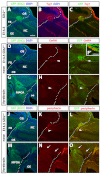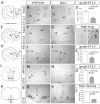Slit2 and Robo3 modulate the migration of GnRH-secreting neurons
- PMID: 22912413
- PMCID: PMC3424043
- DOI: 10.1242/dev.079418
Slit2 and Robo3 modulate the migration of GnRH-secreting neurons
Abstract
Gonadotropin-releasing hormone (GnRH) neurons are born in the nasal placode and migrate along olfactory and vomeronasal axons to reach the forebrain and settle in the hypothalamus, where they control reproduction. The molecular cues that guide their migration have not been fully identified, but are thought to control either cell movement directly or the patterning of their axonal substrates. Using genetically altered mouse models we show that the migration of GnRH neurons is directly modulated by Slit2 and Robo3, members of the axon guidance Slit ligand and Robo receptor families. Mice lacking Slit2 or Robo3 have a reduced number of GnRH neurons in the forebrain, but a normal complement of their supporting axons, pointing to a direct role for these molecules in GnRH neuron migration.
Figures




References
-
- Cariboni A., Rakic S., Liapi A., Maggi R., Goffinet A., Parnavelas J. G. (2005). Reelin provides an inhibitory signal in the migration of gonadotropin-releasing hormone neurons. Development 132, 4709–4718 - PubMed
-
- Cariboni A., Maggi R., Parnavelas J. G. (2007a). From nose to fertility: the long migratory journey of gonadotropin-releasing hormone neurons. Trends Neurosci. 30, 638–644 - PubMed
-
- Cariboni A., Davidson K., Rakic S., Maggi R., Parnavelas J. G., Ruhrberg C. (2011). Defective gonadotropin-releasing hormone neuron migration in mice lacking SEMA3A signalling through NRP1 and NRP2: implications for the aetiology of hypogonadotropic hypogonadism. Hum. Mol. Genet. 20, 336–344 - PubMed
Publication types
MeSH terms
Substances
Grants and funding
LinkOut - more resources
Full Text Sources
Molecular Biology Databases

